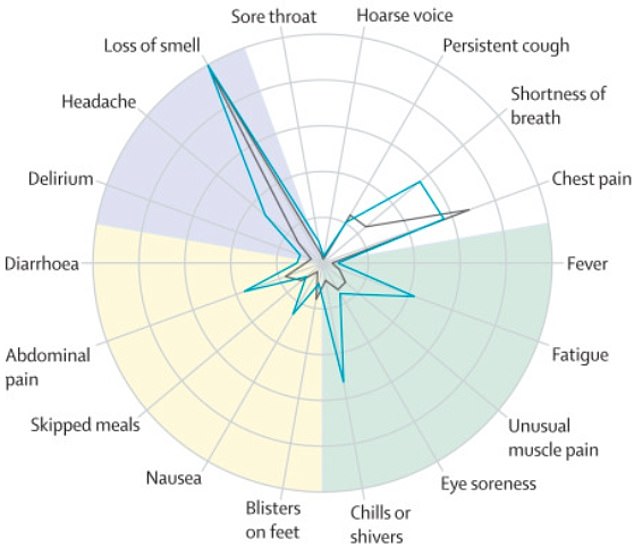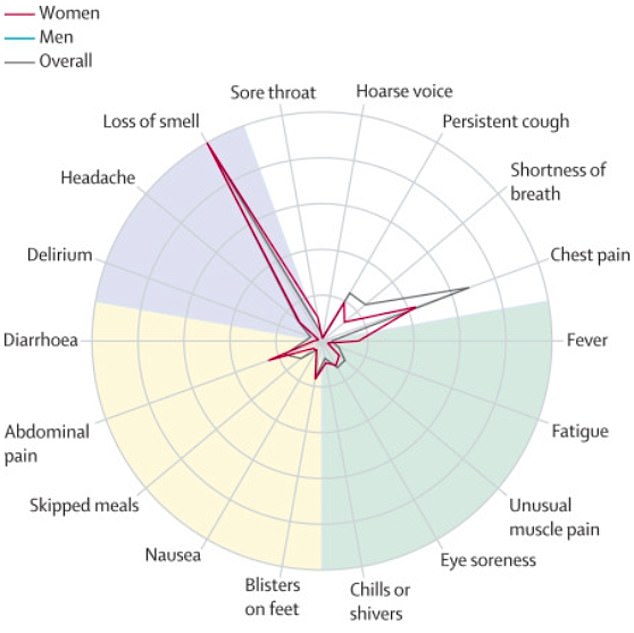Men and women suffer different symptoms from Covid, a study has claimed.
Researchers at King’s College London looked at data from 38,000 infected adults.
They discovered men were more likely to suffer shortness of breath, fatigue, chills and a fever.
Meanwhile, a loss of smell, chest pain and a persistent cough appeared to be most common among women.
Traditionally, Covid’s main three symptoms are considered to be fever, a persistent cough and loss of smell.
But academics found fever was not an early feature of the disease in any age group — despite being a known symptom.

Researchers at King’s College London looked at data from 38,000 adults and found men (blue line) were more likely to be short of breath, fatigued, have chills and a fever after being infected with Covid
The research — which took data from Zoe’s Covid Symptom Study app — also found those aged 60 and above were more likely to report diarrhoea.
And a loss of smell — one of the hallmark signs of the illness — was less common among older adults.
The findings, published in the journal Lancet Digital Health, are based on modelling using artificial intelligence to predict early signs of Covid infection.
Data from the app has previously shown vaccines had helped turn Covid into a ‘bad cold’.
Double-jabbed Britons who catch the virus are now more likely to suffer a headache, runny nose, sneezing and a sore throat than the ‘classic’ three symptoms.
Officials have repeatedly refused to expand the Covid symptoms list to include more warning signs, despite evidence showing the disease has changed.

Meanwhile, a loss of smell, chest pain and a persistent cough appeared to be most common among women
Lead author Claire Steves, from King’s College London, said: ‘It’s important people know the earliest symptoms are wide-ranging and may look different for each member of a family or household.
‘Testing guidance could be updated to enable cases to be picked up earlier, especially in the face of new variants which are highly transmissible.
What are the symptoms of Covid?
The NHS has listed a high temperature along with a new and continuous cough as the main symptoms of the virus.
It subsequently added a loss or change to smell or taste as a symptom of the virus, following pressure from Covid campaigners.
Most people who catch Covid and show symptoms have at least one of these, according to the NHS.
But other studies have claimed a loss of appetite, skin rashes, hives, muscle pain and diarrhoea can all be symptoms of Covid.
The US recognises 11 symptoms, which also include a headache and runny nose.
Around a third of people with the virus are asymptomatic and can unknowingly pass it on to others.
Source: NHS
Advertisement
‘This could include using widely available lateral flow tests for people with any of these non-core symptoms.’
Overall, the research team examined 18 different symptoms associated with Covid.
Early signs included a loss of smell, chest pain, persistent cough, abdominal pain, blisters on the feet, eye soreness and unusual muscle pain.
They said their modelling study was used on the the original strain of the virus that first appeared in Wuhan, China, as well as the Alpha ‘Kent’ variant of coronavirus.
However, they added, that the findings suggest the symptoms of the Delta variant and any new variants to come will also differ across population groups.
Study co-author Dr Marc Modat said: ‘As part of our study, we have been able to identify that the profile of symptoms due to Covid differs from one group to another.
‘This suggests the criteria to encourage people to get tested should be personalised using individuals’ information such as age.
‘Alternatively, a larger set of symptoms could be considered, so the different manifestations of the disease across different groups are taken into account.’
The ZOE Covid symptom study was one of the first studies to spot loss of taste and smell as a symptom of the virus.
Experts behind the research successfully lobbied ministers to have it added to the official warning signs list.
Since then it has repeatedly called for the symptom list to be expanded to ensure more infections are caught in the early stages, helping to curb the spread of the virus.
They point to other countries that have recognised far more symptoms of an infection with the virus.
For example, authorities in the US have identified more than 20 symptoms as a possible sign of a Covid infection.
Guidance says Britons should only get tested for Covid if they are suffering from the three key warning signs, or if they are told to get swabbed by Test and Trace.
Source link : https://www.dailymail.co.uk/news/article-9843873/Covid-19-UK-coronavirus-symptoms-differ-genders.html











